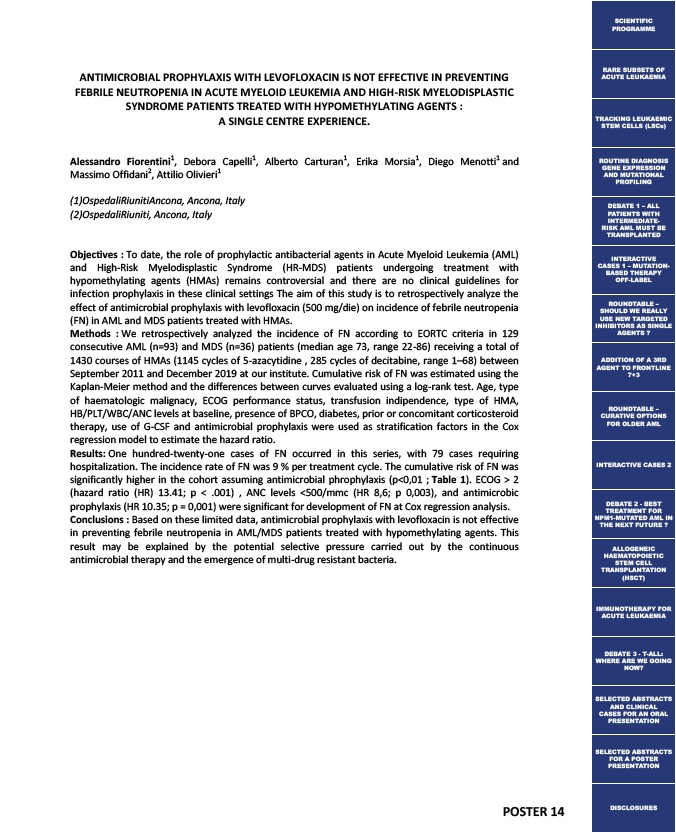
ANTIMICROBIAL PROPHYLAXIS WITH LEVOFLOXACIN IS NOT EFFECTIVE IN PREVENTING
FEBRILE NEUTROPENIA IN ACUTE MYELOID LEUKEMIA AND HIGH-RISK MYELODISPLASTIC
POSTER 14
SYNDROME PATIENTS TREATED WITH HYPOMETHYLATING AGENTS :
A SINGLE CENTRE EXPERIENCE.
Alessandro Fiorentini1, Debora Capelli1, Alberto Carturan1, Erika Morsia1, Diego Menotti1 and
Massimo Offidani2, Attilio Olivieri1
(1)OspedaliRiunitiAncona, Ancona, Italy
(2)OspedaliRiuniti, Ancona, Italy
Objectives : To date, the role of prophylactic antibacterial agents in Acute Myeloid Leukemia (AML)
and High-Risk Myelodisplastic Syndrome (HR-MDS) patients undergoing treatment with
hypomethylating agents (HMAs) remains controversial and there are no clinical guidelines for
infection prophylaxis in these clinical settings The aim of this study is to retrospectively analyze the
effect of antimicrobial prophylaxis with levofloxacin (500 mg/die) on incidence of febrile neutropenia
(FN) in AML and MDS patients treated with HMAs.
Methods : We retrospectively analyzed the incidence of FN according to EORTC criteria in 129
consecutive AML (n=93) and MDS (n=36) patients (median age 73, range 22-86) receiving a total of
1430 courses of HMAs (1145 cycles of 5-azacytidine , 285 cycles of decitabine, range 1–68) between
September 2011 and December 2019 at our institute. Cumulative risk of FN was estimated using the
Kaplan-Meier method and the differences between curves evaluated using a log-rank test. Age, type
of haematologic malignacy, ECOG performance status, transfusion indipendence, type of HMA,
HB/PLT/WBC/ANC levels at baseline, presence of BPCO, diabetes, prior or concomitant corticosteroid
therapy, use of G-CSF and antimicrobial prophylaxis were used as stratification factors in the Cox
regression model to estimate the hazard ratio.
Results: One hundred-twenty-one cases of FN occurred in this series, with 79 cases requiring
hospitalization. The incidence rate of FN was 9 % per treatment cycle. The cumulative risk of FN was
significantly higher in the cohort assuming antimicrobial phrophylaxis (p<0,01 ; Table 1). ECOG > 2
(hazard ratio (HR) 13.41; p < .001) , ANC levels <500/mmc (HR 8,6; p 0,003), and antimicrobic
prophylaxis (HR 10.35; p = 0,001) were significant for development of FN at Cox regression analysis.
Conclusions : Based on these limited data, antimicrobial prophylaxis with levofloxacin is not effective
in preventing febrile neutropenia in AML/MDS patients treated with hypomethylating agents. This
result may be explained by the potential selective pressure carried out by the continuous
antimicrobial therapy and the emergence of multi-drug resistant bacteria.
SCIENTIFIC
PROGRAMME
RARE SUBSETS OF
ACUTE LEUKAEMIA
TRACKING LEUKAEMIC
STEM CELLS (LSCs)
ROUTINE DIAGNOSIS
GENE EXPRESSION
AND MUTATIONAL
PROFILING
DEBATE 1 – ALL
PATIENTS WITH
INTERMEDIATE-RISK
AML MUST BE
TRANSPLANTED
INTERACTIVE
CASES 1 – MUTATION-BASED
THERAPY
OFF-LABEL
ROUNDTABLE –
SHOULD WE REALLY
USE NEW TARGETED
INHIBITORS AS SINGLE
AGENTS ?
ADDITION OF A 3RD
AGENT TO FRONTLINE
7+3
ROUNDTABLE –
CURATIVE OPTIONS
FOR OLDER AML
INTERACTIVE CASES 2
DEBATE 2 - BEST
TREATMENT FOR
NPM1-MUTATED AML IN
THE NEXT FUTURE ?
ALLOGENEIC
HAEMATOPOIETIC
STEM CELL
TRANSPLANTATION
(HSCT)
IMMUNOTHERAPY FOR
ACUTE LEUKAEMIA
DEBATE 3 - T-ALL:
WHERE ARE WE GOING
NOW?
SELECTED ABSTRACTS
AND CLINICAL
CASES FOR AN ORAL
PRESENTATION
SELECTED ABSTRACTS
FOR A POSTER
PRESENTATION
DISCLOSURES